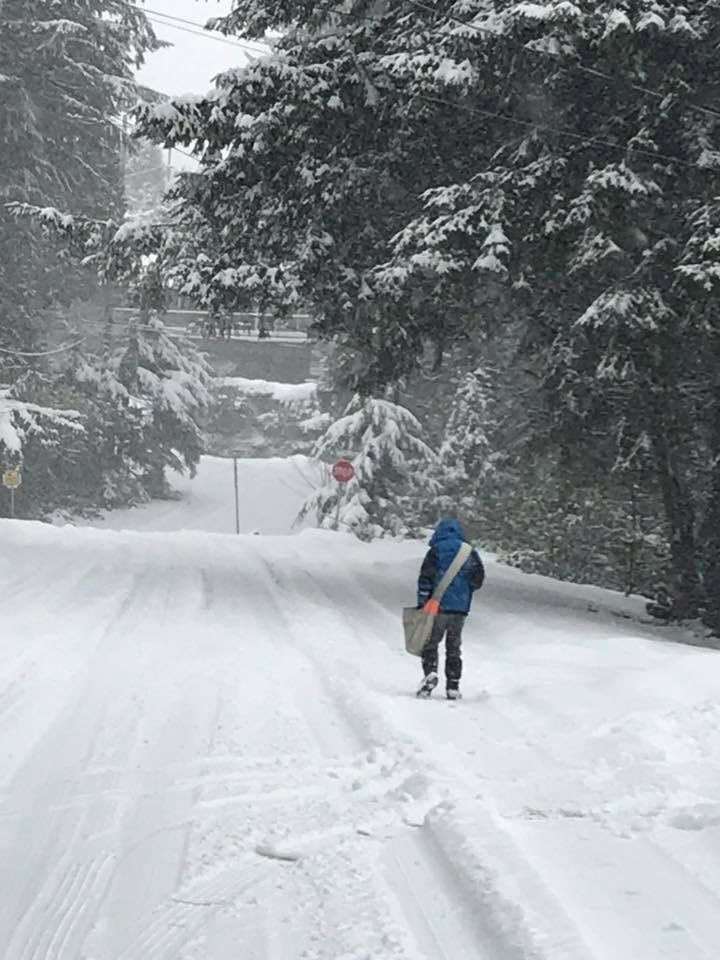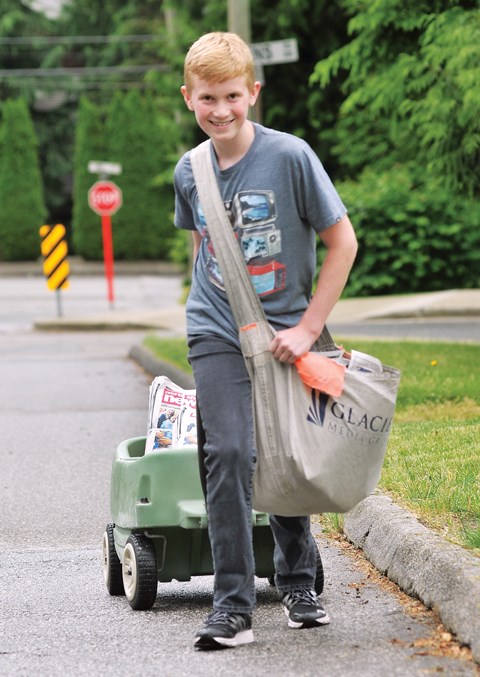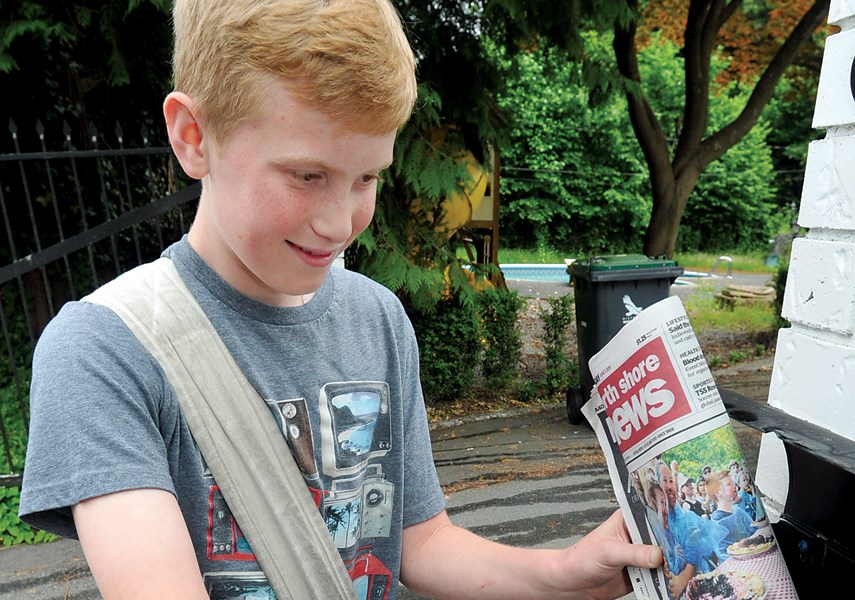Harrison Taylor is pulling a wagon loaded with the North Shore News up a leafy tree-lined street.
It’s a mix of heritage homes and older ranchers on tidy lots, interspersed with much bigger houses where the old ones got torn down.
It’s also a neighbourhood with hills, which as a newspaper carrier, Harrison is well aware of.
“You wouldn’t notice if you’re driving,” he says. “You notice if you’re walking.”
The wagon trundles up East Queens Road, past houses with rose bushes where he’s known the neighbours for years and a large new house where he doesn’t. “The people who live there, we never see them at all. We’re not even sure people live there,” he says.
Harrison has lived all 13 years of his life in this neighbourhood. His paper route takes him past the church hall where his older sister once attended a Montessori preschool and just a few blocks away from Holy Trinity Elementary, where he just finished Grade 7.
Near the corner of this street, there’s a house where a big tree crashed down across the roof in a windstorm.
“It was crazy,” says Harrison. A port-a-potty left from the crew that came to fix the roof still stands at the end of the driveway.
This afternoon, neighbour Anne Patterson is out with her dog Sophie, enjoying the sprinkle of warm summer rain. “A bit of rain is good,” she says, eyeing the gardens.
Harrison is “the best carrier,” she says. “The paper is always there. It’s not thrown on the driveway.”
“I don’t think anyone’s going to have a bad word to say,” she says. “If they do, send them to me.”
Harrison rounds the corner and is up a block and on to East Kings Road.
As one of 60 kids who deliver the paper and 31 adult newspaper carriers, Harrison is part of a small army who get the North Shore News to about 37,000 houses and 13,000 apartments on the North Shore twice a week, on Wednesdays and Fridays.
Papers start arriving from the printer at the newspaper’s Brooksbank warehouse in the middle of the night, and the first adult carriers and delivery agents – who will drive bundles of papers out to the younger carriers – start arriving at 4 a.m., says Paul Watson, distribution manager at the News.

Adults with a car can deliver between 500 and 3,000 papers in a day. Most kids have a route with between 40 and 150 houses.
“The easier and flatter the route, the more children will apply,” says Watson.
Harrison usually starts his route around 4 p.m. When he comes home from school, several stacks of zap-strapped newspaper bundles are already waiting on his porch.
There are 78 houses on Harrison’s route. Friday’s paper is smaller, says Harrison, and usually fits in four bundles, while Wednesday’s is fatter and comes in five bundles. On Fridays, on the sections of the route he walks with a newspaper bag, “I’ll put 20 papers in my bag instead of 15,” he says. “On Fridays the papers have less ads.”
The News gives Harrison a sheet noting which houses to deliver to, which don’t want the paper and who’s away this week.
But as an experienced carrier, Harrison has most of that in his head already. “I know a lot of people very well,” he says of his neighbours.
When he started the route about three years ago, “I started because I wanted to make a bit of extra money,” he says.
He had a couple of friends who were newspaper carriers. One split the paper route with siblings. Another “had a very flat route,” says Harrison.
This is not one of those.
“I’m really hilly in this area.”
Equipment for the job is simple – a newspaper bag and a wagon or cart to pull the newspapers around in.
Like many jobs, it’s not like it is in the movies. “When you see it in the movies, it’s usually someone on their bike going really fast,” says Harrison, sounding slightly exasperated. Kids in his class have asked him if that’s how he does his paper route.
“I’m like, ‘How would I do it on my bike?’”
When he first started the paper route, his dad helped him the first few months to figure out a route. The trick is to be efficient, and make sure you’re pulling as little weight uphill as possible. Also, “we don’t want to back track,” says Harrison.
Papers tend to be lighter in the summer, which is good, says Harrison, because that’s when he’s pulling the wagon up hills in the heat.
Come fall, however, they will fatten up again, get heavier and be filled with more flyers. “Black Friday is usually the worst. And Christmas,” he says. “Black Friday they double stuff all the papers (with flyers). It takes a lot longer.”

If you want to know the state of the local economy, a newspaper carrier knows.
Kids who deliver papers make eight cents a paper plus extra for flyers and door hangers. For delivering a light summer paper on a route like Harrison’s, young carriers make around $10, twice a week. In the fall they make more. Then there are tips, especially at Christmas.
“This year I made $250 in tips,” says Harrison.
The best tippers are people who chat with him or the ones who used to be carriers themselves. “They know the experience,” says Harrison.
Delivering the paper has also led into some other work around the neighbourhood, like shovelling snow in winter. There’s also been talk of babysitting and dog sitting and picking up the mail for neighbours. “One house wanted me to water their plants while they are away,” he says.
“And my dad recently bought a lawnmower so I might start mowing lawns.”
Harrison heads down the gentle slope of East Kings Road lined with chestnut trees. He goes past one house that has cool decorations at Halloween including figures that jump out at you and move.
There’s a poster on a telephone pole for a missing black kitten named Lulu. “One time I saw a missing parrot poster,” says Harrison.
He’s seen raccoons in the neighbourhood before. “At one point there were cougar signs up here, cougar warnings,” he says. But he never saw one.
Wildlife on his route is mostly limited to birds and squirrels, which scold from the high branches of the trees along the street.
“I’ve seen owls,” he says.
He comes up to a large grey house where a cacophony of barking erupts from inside as he walks up the steps.
“It has these two huge dogs. They bark really loud,” he says. “They jump and belly slam the door.”
For newspaper carriers, dogs are an occupational hazard. Harrison says a dog bit him once, though it wasn’t serious. He takes most of the dogs in stride. Just around the corner is another dog house.
“The first time I walked up their driveway, their dog was going crazy,” he says. “The next day there was a sign saying do not enter that way.”
The sign is still very much in evidence, along with two more “Beware of Dog” signs, one in black and one in red, to underline the point.
“There are a lot of dogs on this route,” says Harrison.
A warm slightly overcast day like today is optimal for paper delivery.
“The best weather is not really hot. Maybe 15 degrees or something,” he says.
It doesn’t always work out that way. In North Vancouver, there is a lot of rain. And during the occasional winter cold snap, it can be hard to pull the wagon in the snow, he says. The hills can also get slippery.
In winter, Harrison starts his paper route a bit earlier and wears a reflective vest and visor. Some drivers aren’t paying attention for pedestrians, he’s learned. “They’re not busy streets at all so they just think they can go really fast.”
A small stretch of 29th Street – where cars are quickly zipping by – is one of the busier ones on his route. But Harrison only does a couple of houses here and he doesn’t cross the street. Luckily, his route also stops before the dreaded 29th Street hill.
Back on East Queens, he’s hit the sweet spot on his route – a row of townhouses. It was a woman who lives in one of these who gave him his biggest ever $50 tip at Christmas. Also, “They’re close together,” he says. “You can do them quick and fast.”
There are a few houses on the route that Harrison doesn’t deliver to but he doesn’t know the reason.
Usually, it’s something practical. Only once in a while do people cancel their papers because they’re upset about a story or an ad, says Watson, the distribution manager. A scantily clad lingerie model in an ad once raised some hackles. So did a photo of people involved in a cancer fundraiser wearing T-shirts telling cancer rather rudely just what it should do to itself. Readers were not amused.
Harrison passes a fig tree hanging green fruit over a fence, and carports stacked with recycling tubs and garbage carts. There’s a boat parked in a yard where he often stops and talks to a man who works on projects in his carport. Garden gnomes stare back at him from near the back door.
Houses here are on the flat and close together. “This part is really nice,” says Harrison. “Then I have to go up this huge hill.”
This part of Lonsdale is the busiest street he walks on his route and also the steepest.
He pulls the wagon up past the Queen’s Cross Pub, a gas station, a realty office and a daycare where a 7-11 used to be.
That’s where he used to see an odd guy hanging out in the parking lot sometimes, hoodie pulled up to shade his face. He told his friend’s dad, a police officer, about it. “He might be a drug dealer,” says Harrison. “I don’t know.”
“They were going to build condos there but they didn’t,” he says. “Now they’re repainting it.”
We pass another missing cat poster. Dobby, a Siamese described as “shy and cautious,” has been missing for over two weeks.
Back on East Kings, he passes a house with a wading pool in the front yard, where kids flying down the driveway on their sleds almost took him out once. The two-storey, 1960s-era house across the street with a curtain drooping from a basement window has recently sold for $1.3 million. The realty listing described the street as an “excellent sought-after neighbourhood.”
To toss or not to toss is an issue most carriers have to figure out.
For starters, there’s a way to hold the paper – grabbing from the outside, so the flyers are pointing in toward the fold. Holding it the other way means the flyers will spill out. That’s a rookie move.
A man on the street stops Harrison, asking if he has an extra. “Do they let you throw them? We used to throw them,” the man tells him. “I was a Province carrier.”
He tucks the paper into a neat firm rectangle, showing Harrison how to prepare for a toss, demonstrating a bit of newspaper origami still vivid after many decades. “You know, sometimes when you’ve gotta go up eight steps, sometimes it’s easier,” he says.
“We used to do it on bikes. That goes back to the ’50s.”
A lot of people tell Harrison how they used to deliver the papers.
For the most part, Harrison is still in the non-tossing camp. “I think it’s just disrespectful to do it,” he says. “If I throw it, all the ads fly out.”
He prefers to tuck the papers under a mat on the porch if possible. “I make sure it pokes out a bit so they see it.”
There have only been a couple of times when he had to stop delivering – once when he had pneumonia and once when he broke his leg skiing. “I was in a wheelchair for two months,” he says. His dad filled in until the newspaper got a temporary replacement and included notes explaining what happened. It was right after Christmas and he’d just earned some big tips.
“We didn’t want them to think I took their money and just left,” says Harrison.
He approaches the corner of St. Georges Avenue and East Queens and the last house on his route. A cat named Gypsy lives around here, says Harrison. She’s friendly. And not lost.
At this point he’ll often check to see how long it took him to do the route. Doing the papers usually takes anywhere from an hour to an hour and a half, depending. “When I first did it, it took two and a half hours,” he says. “It’s taken me two hours on days when it’s heavy and I can’t run.”
It’s about an eight-kilometre walk from beginning to end.
“My dad measured it on his app,” says Harrison.
But he’s also gotten faster and fitter doing the route.
Fifty minutes is his record doing the papers on his own. Once when a friend helped out, “We did it in 30 minutes.”
There are qualities that come in handy as a carrier, says Harrison. You need to be friendly. You need to have willpower. You need to be fit, “so you don’t get tired out.” You need to have a good memory for the houses.
He’s learned a lot about the neighbourhood as a carrier, he says. He’s gotten to know his neighbours in a way he didn’t before.
Next year he’s in high school, so he’ll just wait and see how it goes.
“It’s my first real job ever,” he says. ◆
This story was included in our 50th Anniversary Issue, published Wednesday, Aug. 14, 2019. Click here for more stories from this special anniversary edition.



